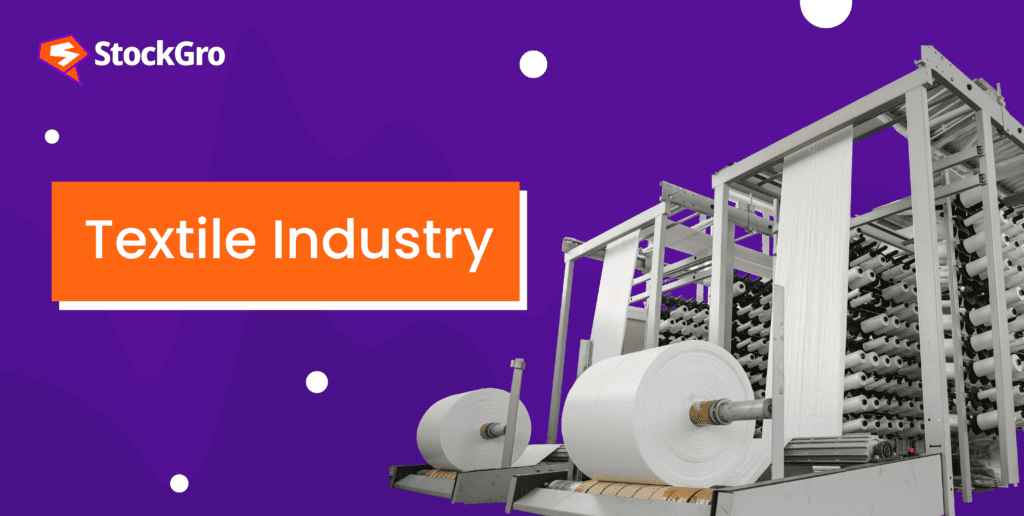
The age-old bell bottoms are back in fashion today. And just as we were getting familiar with the blingy neon clothes, the dreamy pastel clothes started dominating the market. That’s how rapidly the fashion industry in India changes!
While much credit goes to the fashion designers, let’s remember to give credit even to the invisible hands behind all fashion – the textile manufacturers, who produce the raw material for our clothes.
Today’s article is about the textile industry in India, where we discuss textiles’ history, growth and future.
You may also like: Winter 2023: Navigating the effects on the stock market
What is the textile industry?
Textile refers to the basic clothing or fabric made of raw yarn such as wool, cotton, silk, etc.
The textile industry includes all activities related to manufacturing, design and distribution of clothes and associated raw materials.
History of textile industry in India
The Indian textile industry has a history of more than 4000 years. Exports of yarn and fabric from India have been happening since time immemorial, and India was synonymous with “Cotton” during ancient times in countries like Greece. The use of weaving and spinning tools can be seen in the Vedas, one of the oldest Hindu scriptures.
India was a significant exporter of cotton during the Industrial Revolution in Europe in the 17th and 18th centuries. 25% of the global textile trade was managed by Bengal in the 18th century.
Though the industry has existed for the longest time, the post-independence era and liberalisation policies in 1991 have contributed immensely to its growth.
Growth of the textile industry in India
The pre-independence era was favourable for the textile industry, as Mahatma Gandhi focused on replacing British cotton with Indian cotton. This was Gandhiji’s step towards self-reliance to promote the economy, increase employment and reduce poverty.
| Growth of FDI | |
| Year | FDI Inflow (USD Million) |
| 2017-2018 | 2,925 |
| 2018-2019 | 3,124 |
| 2019-2020 | 3,447 |
| 2020-2021 | 3,746 |
| 2021-2022 | 3,993 |
Until 1991, unorganised players dominated the textile industry. However, with the introduction of globalisation, the focus on the textile industry increased. The National Textile Policy of 2000 was one of the significant steps in promoting India’s position on global platforms.
Also read: The pharmaceutical industry in India and its contribution to the world
The textile scenario today
Today, India is one of the top countries in the global textile industry.
The textile industry contributes 2.3% to the country’s GDP and 12% to the total exports from India. It is one of the top 3 employers in the country, with agriculture and construction sectors, providing jobs for around 45 million people directly and 100 million people in associated sectors.
India ranks number two globally in manufacturing PPE (Personal Protective Equipment), and man-made fabrics polyester and viscose. It stands second to China in silk production and the country produces 95% of hand-woven fabrics worldwide.
Technical textiles in India
Technical textiles deal with manufacturing clothing for specific purposes such as industrial, medical, automotive and other applications.
PPE clothing is an example of technical textiles. India has over 600 companies certified to produce PPE clothing.
| Domestic market size of technical textiles in India (USD Million) | |
| Year | Market size |
| 2013-14 | 10,900 |
| 2014-15 | 12,000 |
| 2015-16 | 12,500 |
| 2016-17 | 15,000 |
| 2017-18 | 17,000 |
| 2018-19 | 19,000 |
| 2019-20 | 20,000 |
| 2020-21 | 15,000 |
| 2023-24E | 40,000 |
- Cotton textile industry in India
India is one of the top producers globally for jute and cotton. Cotton has been in production since ancient times, and it was one of the primary products used in barter trades. The cotton basket of India consisting of 4 states- Maharashtra, Gujarat, Andhra Pradesh and Telangana – together produce 2/3rd of the total cotton in the country.
- Future of the textile industry in India
The Indian textile market is expected to reach $250 billion in production and $100 billion in exports by 2030. The global market worth of Indian companies producing PPE was $52.7 billion in 2019 and is expected to touch $92.5 billion by 2025.
The government is currently focussing on improving the man-made fabric industry, by launching incentive schemes with an investment of ₹10,683 crores.
Also read: Connecting communities: A mobile broadband case study
Top textile stocks in India
Before going through the top stocks in the industry, let’s understand some critical parameters to analyse these stocks:
- Market capitalisation: Analysing the market capitalisation is essential not just for textile stocks but for every kind of stock. Generally, large-cap stocks are powerful against market downtrends, minimising price fluctuations.
- Production capacity: India is one of the top producers and exporters of textiles in the global market. It is necessary to break down the numbers and analyse the contribution of each company to global production.
- Ratios like P/E, and net profit: Mathematical ratios like Price to Earning, net profit, earnings per share, etc., determine the profits on investments which is crucial in making investment decisions.
Major textile stocks in India according to market capitalisation on NSE and BSE (As of 04 Dec 2023):
- Page Industries – Established in 1994 by Sundar Genomal, Page Industries is a leading manufacturer of swimwear, innerwear, socks, etc. Headquartered in Bengaluru, it has the exclusive license to sell the products of Jockey International in India and neighbouring countries.
| NSE share price | NSE market cap | BSE share price | BSE market cap |
| ₹37,700.00 | ₹42,151.21 crore | ₹37,816.35 | ₹42,179.88 crore |
- KPR Mills – Founded in 1984, KPR Mills is one of the largest manufacturers of fabric, man-made fabric and readymade garments.
| NSE share price | NSE market cap | BSE share price | BSE market cap |
| ₹870 | ₹29,751.49 crore | ₹883.95 | ₹29,464.37 crore |
- Trident Group – Founded in 1990 by Rajinder Gupta, Trident Group began as a yarn manufacturer and is now a prominent manufacturer of home textiles.
| NSE share price | NSE market cap | BSE share price | BSE market cap |
| ₹36.35 | ₹18,498.32 crore | ₹36.67 | ₹18,508.51 crore |
- Welspun India – Founded in 1985, the company has a revenue of 9,377 crores. It primarily produces terrycloth products such as towels, foot rugs, blankets and home furniture.
| NSE share price | NSE market cap | BSE share price | BSE market cap |
| ₹156.60 | ₹15,237.96 crore | ₹156.35 | ₹15,247.68 crore |
- Swan Energy – Founded in 1909 and headquartered in Mumbai, Swan Energy is a leading name in India’s textile world. The firm’s business specialises in dyeing and printing various kinds of fabrics.
| NSE share price | NSE market cap | BSE share price | BSE market cap |
| ₹419.45 | ₹10,959.15 crore | ₹419.25 | ₹10,925.56 crore |
- Raymond – Founded in 1944 by Vijaypat Singhania, the Raymond Group is one of the most popular names in the textile industry. Apart from textiles and apparel, Raymond also has its presence in consumer care, engineering and realty.
| NSE share price | NSE market cap | BSE share price | BSE market cap |
| ₹1,582.75 | ₹10,403.81 crore | ₹1,577 | ₹10,405.81 crore |
- Alok Industries – Established in 1986, Alok Industries has its business in home textiles, technical textiles, yarn, ready-made garments, etc. The company is owned by Reliance Industries and is headquartered in Mumbai.
| NSE share price | NSE market cap | BSE share price | BSE market cap |
| ₹20 | ₹9,781.52 crore | ₹20.02 | ₹9,766.63 crore |
Bottomline
The textile industry has been playing a vital role in building the country’s self-reliance since the pre-independence era. Even today, the textile sector is one of the important components of the “Make in India” initiative by the Indian government.
The growth prospects of the textile industry offer promising opportunities, both in terms of revenue and employment to the government and citizens of the country.

